Sea Kayakers are frequently in a very dynamic environment. Frequently we deal with wind, waves, tides, and currents. To make it even more confusing, these forces interact with the land to produce micro environments that are constantly changing. To paddle efficiently, a kayaker must learn to “read” the water to see currents, rips, eddies, and hidden hazards. This skill allows us to use wind, and currents to our advantage instead of constantly fighting our way through the water. For experienced paddlers, refining water-reading ability can make the difference between a smooth crossing and a draining battle, or between an exhilarating play in tidal races and an unplanned swim.
Advantages of Learning to Read the Water
Unlike hiking a trail, the ocean doesn’t provide a fixed path. Every stroke is affected by current, tide, wind, and underwater features. Navigational charts give the big picture, but they can’t show the micro-conditions at a headland or how today’s wind interacts with last week’s sandbar shift. Reading the water in real time gives paddlers an immediate advantage.
By reading the water it is possible to increase:
§ Efficiency – Find eddies and current edges to save energy.
§ Safety – Anticipate rips, boils, and shallows before they surprise you.
§ Performance – Use currents as conveyor belts, align strokes with flow, and surf standing waves.
§ Enjoyment – The water becomes your friend, not an opponent.
Surface Clues
We learn to read water by observing the surface and identifying subtle changes in water texture, we observe subtle changes in color, how the water interacts with floating debris and how it interacts with fixed objects or the shoreline.
Texture and Color Changes
Even subtle surface differences reveal what lies below. Darker, smoother patches often mark deeper channels. Brighter, choppier water can indicate shoals, shallows, or wind-against-tide conditions. Pay attention to sudden steepening of waves or breaking of waves. These signal submerged reefs, sand bars, or ledges. Being aware of these clues can prevent a surprise interaction with a breaking wave where you expected calm water.
The photo below shows the differences in color between the deeper channel in Charleston Harbor, darker greenish blue, and the lighter shallows. Also notice the texture change at the bottom of the photo indicating that this area is sheltered from the wind.
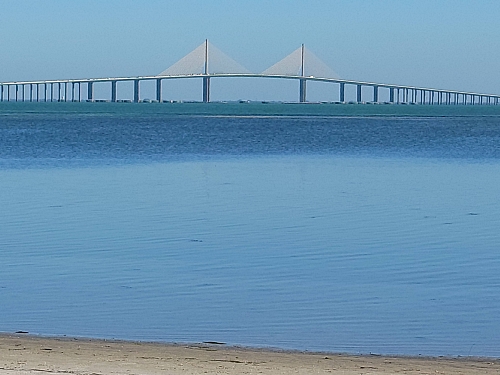
Foam, Debris, and Seaweed Lines
Floating material collects where currents converge. A neat foam line stretching across an inlet often shows a boundary between flows. Seaweed mats caught in circles can reveal hidden eddies. These markers are especially useful in tidal passages where water movement may be complex and constantly shifting.
It is sometimes difficult to tell the direction of the current flow, especially when wind is blowing the surface water against the real current. Observation of partially submerged debris will indicate current flow that is not affected by the wind.
Surface Features
Eddies and Current Boundaries
When current strikes a solid object—headland, rock, pier the water must wrap around this obstruction. Current speed increases because the water must pass through a constriction. As the flow passes around the object, water from downstream is drawn into the current flow and creates a reverse flow forming an eddy. On the surface of the eddy, the water may appear smoother with foam swirling in circles or drifting upstream. The dividing line between the eddy and main current is marked by a change in water texture possibly with debris or foam. It tends to be a sharper line near the obstruction and widens as the flow moves downstream.
When there is swift current and a large difference between the speed of the main current and the speed of the eddy, you need to take care when crossing the eddy line.
In the photo below, notice the differenced in water texture between the main current flowing from under the bridge and the eddys, closer to the shorelines.
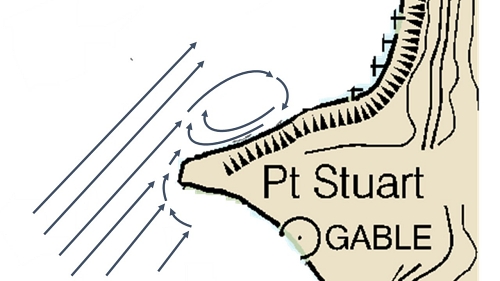
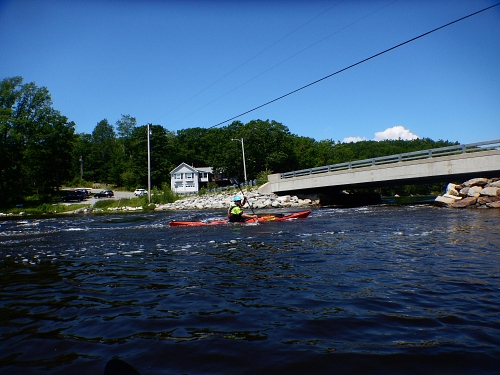
Boils and Upwellings
Boils occur when deep current is forced upward by underwater features. On the surface, they look like rounded, bulging patches, sometimes shimmering. They can destabilize your kayak, lifting or tilting unpredictably. The trick is not to fight them but to stay relaxed, knees and hips loose, letting the kayak ride the motion. Boils are common near constrictions or tidal races and can appear suddenly.

The following photo illustrates a boil in the lower left corner.
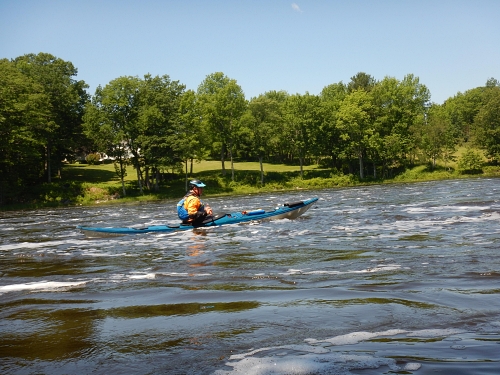
Tide Rips and Races
A rip current often looks deceptively calm: a smooth tongue of water flowing seaward between lines of breaking waves. When doing a beach launch in a kayak, it’s an express lane through the surf. Sometimes it could be an unplanned ride offshore. We were standing at the southern end of Smith the southern end of the barrier islands on the Virginia Eastern Shore. It was a beautiful day with light wind and flat calm conditions. The current wasn’t obvious until you were in it. If we had opted to paddle out, we would not have been able to come back until slack.
In the following photo, notice the change in color and texture of the water in the rip current.
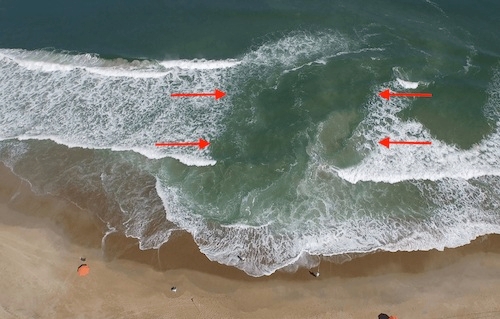
Tide races form when large volumes of water are forced through constricted areas, producing standing waves or haystacks. Typically, these can be seen around points where there is an extended sandbar. Tybee Inlet is known for its tide races. This area has a large tidal range and ebb currents flowing from Tybee Creek are strong. The shallow waters in Tybee Inlet are perfect for tide races to develop. By looking at the chart and the tide and current predictions, you should be able to anticipate how the water might behave.
Common Pitfalls
Reading the water is a skill that requires practice and sometimes the sea holds surprises. Here are some ways to avoid trouble.
§ Don’t assume that calm is always safe. Smooth tongues may be due to strong current rips.
§ Use the information provided by a chart wisely. Understand and combine the information provided by the chart with the information provided by weather and tidal information to predict what you might find. Then compare your predictions with your actual observations.
§ Don’t ignore the impact that wind has on water. Wind-against-tide exaggerates the waves and may actually overpower the current.
§ Don’t fight the water, you will never win. Fighting rough conditions with a stiff body and constant bracing increases instability. Learn to relax sit tall, relax the hips, and learn to dance with the water.
Conclusion
Learning to read the water can make paddling easier and safer. Practice your observation skills every time you paddle. Learn to identify small eddies along the shoreline and use these to your advantage when paddling against the current. Learn to recognize texture changes in the water and use these to find shelter from the wind. Learn to identify safe zones when paddling in challenging conditions. When you learn to read the water and adjust to conditions, the water is truly your friend.
Paddle safely
Paula Hubbard
CPA Coordinator.

Share This
